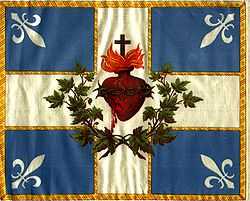Saint-Jean-Baptiste Society



The Saint-Jean-Baptiste Society (French: Société Saint-Jean-Baptiste) is an institution in Quebec dedicated to the protection of Quebec francophone interests and to the promotion of Quebec Sovereignism. Its current President is Mario Beaulieu.
History
The Society was created by journalist Ludger Duvernay in Lower Canada. It evolved out of the Société Aide-toi et le ciel t'aidera ("help yourself and Heaven will help you") founded by Duvernay on March 8, 1834. Most notably, it made June 24, St. John the Baptist day, the national day of the Quebecers. In 1922, June 24 became a public holiday in Quebec, and since 1977 it has been the national holiday of Quebec.
In the 1830s, Lower Canadians of British and (French) Canadian origin founded various charitable and social societies. On December 19, 1834, the English of Lower Canada established the Saint George's Society of Montreal and the Saint George's Society of Quebec on October 12, 1835. The Irish of Lower Canada founded the St. Patrick's Society of Montreal on March 17, 1834 also. The Canadiens founded what would become the Saint-Jean-Baptiste Society on June 24, 1834. On February 6, 1835, the Scots of Lower Canada established Saint Andrew's Society of Montreal. The German Society of Montreal was also founded in 1835.
The Society adopted the drapeau Carillon Sacré-Coeur in the 19th century and its association with the flag was made quasi-official by the Legislative Assembly of Quebec in 1926. Between 1903 and the 1940s it was promoted as "the flag of French Canadian Catholics." It was the model for the Flag of Quebec and inspired Quebec politician René Chaloult, one of the designers of the Quebec flag. This flag has since been largely forgotten except as a family heirloom.
Although similar societies also existed in other parts of British North America or the United States, the societies of Lower Canada were created in a different context. The Saint-Jean-Baptiste Society was established to promote French-Canadian interests within Canada and to preserve the French language and culture and the Roman Catholic religion. It has been active in the social, cultural, educational, political, and economic spheres. The society was instrumental in the creation of the École des Beaux-Arts de Montréal, the École des Hautes Études Commerciales de Montréal, the Monument-National, and the Société nationale de fiducie. In 1899, it created the Caisse nationale d'économie and contributed to the Chambre de Commerce de Montréal. The Society has also created many organizations to assist in its mission, notably La Fondation du Prêt d'Honneur (1944) and the Fondation J.-Donat-Langelier (1988).
Initially, the society adopted the maple leaf as it emblem, and its Quebec City branch was the first promoter of the song "O Canada" as symbols of the French-Canadian nation, together with the Carillon Sacré-Coeur flag. These symbols have now been embraced by English Canada as national Canadian symbols (a bilingual version of the song eventually became the national anthem of Canada in 1980) and are now seen as contrary to the ideas of the Society and many Quebec nationalists.
The Society had local branches in all the major French-Canadian communities in Quebec, the other Canadian provinces, and the United States. It has however changed considerably over time. When it was created, the French-speaking inhabitants of Canada constituted the only large group wishing to see Canada become an independent country from the British Empire. The Saint-Jean-Baptiste Society was an expression of this desire in all its activities. The group, however, was not anti-royalist; for instance, the society's President in 1959 requested, with the support of the Mayor of Quebec City, that Elizabeth II, Canada's queen, light the main bonfire on the eve of Saint-Jean-Baptiste Day; though the petition was ultimately rejected by Howard Graham, the Queen's Canadian Secretary at the time.[1]
During the 20th century, the Saint-Jean-Baptiste Society eventually focused its action in Quebec and is now a proponent of the independence of Quebec from Canada.
Presently, there are 14 sections of the Société Saint-Jean-Baptiste de Montréal in the Greater Montreal Area. The societies are tied to the Mouvement national des Québécoises et des Québécois (MNQ), which also counts 14 affiliated Saint-Jean-Baptiste societies or sociétés nationales in the rest of Quebec.
Awards
The Society awards a number of prizes for various achievements.
- Patriot of the Year, for the defense of the interests of Quebec (began in 1975)
- Bene merenti de patria, for patriotism (began in 1923)
- Ludger-Duvernay Award, for literary talent (began in 1955)
- Olivar-Asselin Award, for journalism (began in 1957)
- Calixa-Lavallée Award, for music (began in 1962)
- Louis-Philippe-Hébert Award, plastic arts (began in 1971)
- Victor-Morin Award, for theater (began in 1971)
- Esdras-Minville Award, for social science (began in 1978)
- Maurice-Richard Award, for excellence in sports (began in 1979)
- Léon-Lortie Award, sciences (began in 1987)
See also
- List of Presidents of the Saint-Jean-Baptiste Society of Montreal
- Lower Canada Rebellion
- Culture of Quebec
References
- ↑ Buckner, Phillip (2005), "The Last Great Royal Tour: Queen Elizabeth's 1959 Tour to Canada", in Buckner, Phillip, Canada and the End of Empire, Vancouver: UBC Press, p. 76, ISBN 0-7748-0915-9, retrieved 24 October 2009